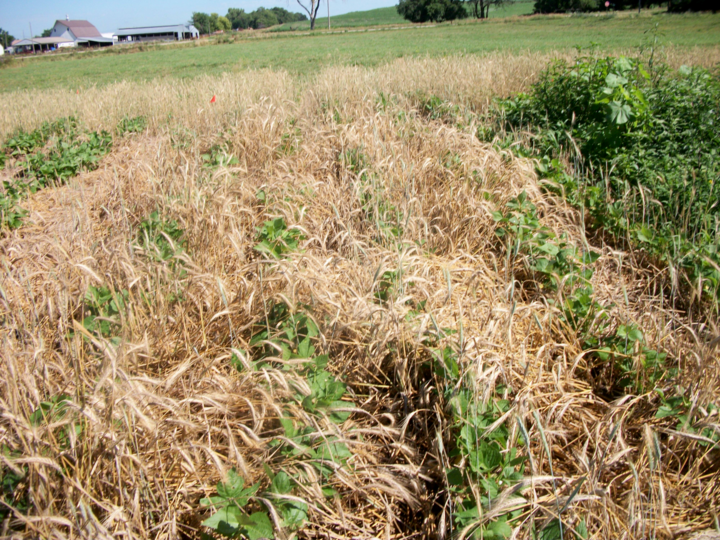Conventional growers can terminate a cover crop at any time before planting soybeans to avoid yield penalties of 0.25 to 0.63 bushels per acre for each day planting is delayed after May 1 (Specht, related story). Likewise, green bean growers can avoid cyclical market price depression by marketing an early crop. Growers who rely on crimping to terminate the cover crop need to crimp by late flowering of the cover crop for adequate weed suppression and by early milk stage to minimize volunteer cover crop seed production.
Best Management Practices
Based on current literature and two years of experiences at the South Central Ag Lab (SCAL) near Clay Center and at three cooperating farms, best management practices for crimping a triticale or rye cover crop to suppress weeds in soybeans include:
- Avoid using this system on land with perennial weed or legume regrowth problems.
- Precede the rye or triticale with a nitrogen source such as manure or a legume that will provide enough nitrogen the following spring to produce at least 3.6 tons/acre biomass. Manure should be free of weed seeds.
- Plant an early-flowering winter small grain at the optimal date recommended for a grain crop.
- Crimp the cover crop at the late-flowering to early milk stage to minimize regrowth and volunteer seed production.
- Use a no-till drill with adequate weight to cut through the mulch.
- Increase the soybean seeding rate by 30% compared to planting in tilled soil.
Practices for Early Bean Planting
Planting soybeans or green beans by mid-May into a mulch crop requires planting into the cover crop within two weeks by roller-crimping or using an early-flowering small grain crop crimped before or after planting.
Planting Before Crimping. In 2016, soybean yield was 16%-55% less at SCAL, and green bean yield was 14%-33% less on a cooperating farm, depending on the triticale cover crop cultivar, with planting these crops into the triticale before crimping compared to roller-crimping the triticale before planting. The roller-crimper threw biomass at an angle across the planted bean row. Where the biomass was thick, bean emergence was impeded and the beans pushed up the mulch. Triticale shown in Figure 1a was crimped before planting green beans. Triticale was pushed up by bean growth when planting green beans before crimping (Figure 1b).


Early Flowering Small Grain Cover Crops
Elbon rye, the earliest flowering commercial rye cultivar adapted to southern Nebraska, flowers from May 12 to 31, depending on the year. Commercial triticale cultivars flower up to two weeks later. However, rye is considered a noxious weed as seed produced by volunteer plants can contaminate wheat grain. Therefore, we focused on triticale and screened 28 early-flowering, high-biomass experimental triticale lines for use as a mulch crop. These were narrowed to seven promising lines. Our earliest experimental triticale lines flowered five to seven days later than Elbon rye.
Performance of Triticale Mulch and Soybeans
In 2017 research plots at SCAL were crimped before planting soybeans. The soybean seeding rate was 210,000 seeds/acre, but the soybean stand was only 112,500 plants per acre. Control plots were hand-weeded and rototilled on May 31 before planting and hoed on July 5 to remove early season weeds. Weeds were counted in all plots on July 24 before hand-weeding the control plots again. Early season weeds were effectively suppressed by the mulch crops. Late-season grass weeds were reduced by 50% and broadleaf weeds were reduced by 67% for the crimped mulch compared to the control plots (see Table 1). Soybean yields were similar for triticale NT15407, Elbon rye, and control plots.
| Entry | Weeds | Soybeans | Triticale | |||
|---|---|---|---|---|---|---|
|
Grass |
Broadleaf July 24 (plants/sq yd) |
Clover July 24 (plants/sq yd) |
Stand July 5 (plants/sq yd) |
Grain Yield @13% m.b. Oct 23 (bu/ac) |
Plant Height May 30 (inches) |
|
| Control | 2.5 | 3.4 | 0.3 | 24.1 | 37.6 | — |
| NT15407 | 1.6 | 1.1 | 3 | 22 | 37 | 56 |
| Rye | 2.9 | 0.6 | 1.1 | 23.2 | 36 | 59.5 |
| NT13443 | 1.9 | 0.4 | 1.1 | 25 | 32.5 | 55.5 |
| NT14407 | 2.9 | 0.9 | 1.1 | 24.1 | 31.7 | 48.5 |
| NT15421 | 2.2 | 0.6 | 1.8 | 26.1 | 31.5 | 48 |
| NT14429 | 0.9 | 0.9 | 2 | 23.8 | 30.6 | 48 |
| NT14408 | 1.3 | 0.5 | 1 | 20.7 | 28.6 | 47.5 |
| NT14415 | 1.7 | 0.8 | 2 | 22.1 | 27.5 | 47.5 |
| LSD (0.05) | 1.5 | 1.3 | 1.3 | NS | 3.5 | 0.2 |
The experimental triticale lines, NT14407 and NT15421 flowered up to six days earlier and performed better than NT15407 and NT13443 in other environments. Because early triticale flowering is important to enable early planting of soybeans, seed of NT15421 has been increased for further research. NT14407 performed well in conventional breeding and forage trials. If you are interested in producing seed of NT14407 or NT15421, please contact the University of Nebraska.
For more UNL mulch-cropping information, see CropWatch's Organic Farming site. Also see A Roller-Crimper for cover Crop Termination and Weed Suppression.
Reviewers: Charles Wortmann and Gary Lesoing

